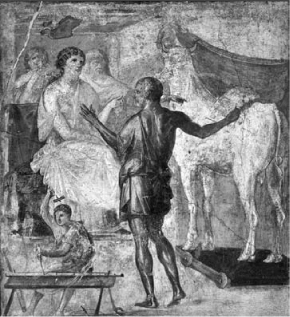Cycladic, Minoan, Mycenaean, and Archaic Greek MythologyDaedalus, Icarus, and Theseus and the Minotaur |
Who was Daedalus? |
The myth of Daedalus was told and retold and often revised by various Greek and Roman writers, most notably Apollodorus and Ovid. The first mention we find is in Homer’s Iliad, where a passing reference indicates that Homer expected his eighth century B.C.E. listeners to know of the story. Homer clearly places Daedalus in the Minoan context, mentioning him as the creator of the dancing ground for the princess Ariadne, the “Lady of the Labyrinth.”
Daedalus was, above all, a master craftsman. It was said, however, that in Athens, when his nephew-apprentice Perdix became almost as adept at building, the jealous Daedalus murdered him, making a flight to Crete necessary. In Crete, Daedalus became an employee of King Minos, who immediately set him to work on various famous projects, most notably the famed Labyrinth. If the Labyrinth was originally a dancing ground for Ariadne, in later myth it became associated with the infamous bull-man, the Minotaur, the son of Queen Pasiphae.
According to the Roman poet Ovid, Daedalus became tired of King Minos’ demands on his time and decided to escape Crete by making wings for himself and his son Icarus. After attaching the wings to their bodies with wax, Daedalus warned his son not to fly too close to the sun. Icarus, thrilled by flying, ignored his father’s warning. He flew up toward the sun, the wax melted, and his wings fell off, and he fell to his death in the sea. Daedalus flew on to Sicily.

A frescoe on the wall of the Casa dei Vetti in Pompeii depicts the tragic hero Daedalus.
